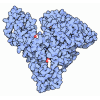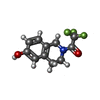Entry Database : PDB / ID : 3omoTitle Fragment-Based Design of novel Estrogen Receptor Ligands Estrogen receptor beta Nuclear receptor coactivator 1 Keywords / Function / homology Function Domain/homology Component
/ / / / / / / / / / / / / / / / / / / / / / / / / / / / / / / / / / / / / / / / / / / / / / / / / / / / / / / / / / / / / / / / / / / / / / / / / / / / / / / / / / / / / / / / / / / / / / / / / / / / / / / / / / / / / / / / / / / / / / / / / / / / / / / / / / / / / / / / / / / / / / / / / / / / / / / / / / / / Biological species Homo sapiens (human)Method / / / Resolution : 2.21 Å Authors Moecklinghoff, S. / van Otterlo, W.A. / Rose, R. / Fuchs, S. / Dominguez Seoane, M. / Waldmann, H. / Ottmann, C. / Brunsveld, L. Journal : J.Med.Chem. / Year : 2011Title : Design and Evaluation of Fragment-Like Estrogen Receptor Tetrahydroisoquinoline Ligands from a Scaffold-Detection Approach.Authors : van Otterlo, W.A. / Rose, R. / Fuchs, S. / Zimmermann, T.J. / Dominguez Seoane, M. / Waldmann, H. / Ottmann, C. / Brunsveld, L. History Deposition Aug 27, 2010 Deposition site / Processing site Revision 1.0 Mar 16, 2011 Provider / Type Revision 1.1 Jul 13, 2011 Group Revision 1.2 Feb 21, 2024 Group / Database references / Derived calculationsCategory chem_comp_atom / chem_comp_bond ... chem_comp_atom / chem_comp_bond / database_2 / struct_site Item _database_2.pdbx_DOI / _database_2.pdbx_database_accession ... _database_2.pdbx_DOI / _database_2.pdbx_database_accession / _struct_site.pdbx_auth_asym_id / _struct_site.pdbx_auth_comp_id / _struct_site.pdbx_auth_seq_id
Show all Show less
 Open data
Open data Basic information
Basic information Components
Components Keywords
Keywords Function and homology information
Function and homology information Homo sapiens (human)
Homo sapiens (human) X-RAY DIFFRACTION /
X-RAY DIFFRACTION /  MOLECULAR REPLACEMENT /
MOLECULAR REPLACEMENT /  molecular replacement / Resolution: 2.21 Å
molecular replacement / Resolution: 2.21 Å  Authors
Authors Citation
Citation Journal: J.Med.Chem. / Year: 2011
Journal: J.Med.Chem. / Year: 2011 Structure visualization
Structure visualization Molmil
Molmil Jmol/JSmol
Jmol/JSmol Downloads & links
Downloads & links Download
Download 3omo.cif.gz
3omo.cif.gz PDBx/mmCIF format
PDBx/mmCIF format pdb3omo.ent.gz
pdb3omo.ent.gz PDB format
PDB format 3omo.json.gz
3omo.json.gz PDBx/mmJSON format
PDBx/mmJSON format Other downloads
Other downloads https://data.pdbj.org/pub/pdb/validation_reports/om/3omo
https://data.pdbj.org/pub/pdb/validation_reports/om/3omo ftp://data.pdbj.org/pub/pdb/validation_reports/om/3omo
ftp://data.pdbj.org/pub/pdb/validation_reports/om/3omo Links
Links Assembly
Assembly
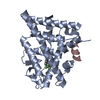
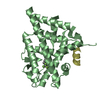
 Components
Components Homo sapiens (human) / Gene: ESR2, ESTRB, NR3A2 / Production host:
Homo sapiens (human) / Gene: ESR2, ESTRB, NR3A2 / Production host: 
 X-RAY DIFFRACTION / Number of used crystals: 1
X-RAY DIFFRACTION / Number of used crystals: 1  Sample preparation
Sample preparation ROTATING ANODE / Type: RIGAKU / Wavelength: 1.5418 Å
ROTATING ANODE / Type: RIGAKU / Wavelength: 1.5418 Å molecular replacement
molecular replacement Processing
Processing MOLECULAR REPLACEMENT / Resolution: 2.21→19.54 Å / Cor.coef. Fo:Fc: 0.919 / Cor.coef. Fo:Fc free: 0.874 / Occupancy max: 1 / Occupancy min: 0.5 / SU B: 5.829 / SU ML: 0.15 / Cross valid method: THROUGHOUT / σ(F): 0 / ESU R Free: 0.228 / Stereochemistry target values: MAXIMUM LIKELIHOOD
MOLECULAR REPLACEMENT / Resolution: 2.21→19.54 Å / Cor.coef. Fo:Fc: 0.919 / Cor.coef. Fo:Fc free: 0.874 / Occupancy max: 1 / Occupancy min: 0.5 / SU B: 5.829 / SU ML: 0.15 / Cross valid method: THROUGHOUT / σ(F): 0 / ESU R Free: 0.228 / Stereochemistry target values: MAXIMUM LIKELIHOOD Movie
Movie Controller
Controller



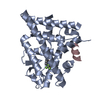
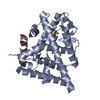



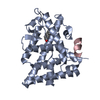
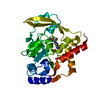
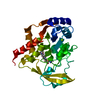
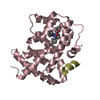
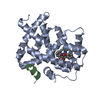

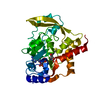
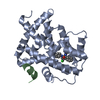
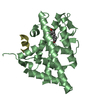
 PDBj
PDBj







